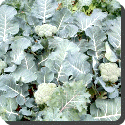 Broccoli — Broccoli is a plant of the Cabbage family, Brassicaceae (formerly Cruciferae). It is classified as the Italica Cultivar Group of the species Brassica oleracea. Broccoli possesses abundant fleshy flower heads, usually green in colour, arranged in a tree-like fashion on branches sprouting from a thick, edible stalk. The large mass of flower heads is surrounded by leaves. Broccoli most closely resembles cauliflower, which is a different cultivar group of the same species, but broccoli is green rather than white. In the United States, the term refers exclusively to the form with a single large head. This form is sometimes called “Calabrese” in the United Kingdom, where sprouting (non-heading) types and those with underdeveloped flower buds are also sold as broccoli.
Broccoli — Broccoli is a plant of the Cabbage family, Brassicaceae (formerly Cruciferae). It is classified as the Italica Cultivar Group of the species Brassica oleracea. Broccoli possesses abundant fleshy flower heads, usually green in colour, arranged in a tree-like fashion on branches sprouting from a thick, edible stalk. The large mass of flower heads is surrounded by leaves. Broccoli most closely resembles cauliflower, which is a different cultivar group of the same species, but broccoli is green rather than white. In the United States, the term refers exclusively to the form with a single large head. This form is sometimes called “Calabrese” in the United Kingdom, where sprouting (non-heading) types and those with underdeveloped flower buds are also sold as broccoli.
There are three commonly grown types of broccoli. The most familiar is sometimes called Calabrese in Great Britain and simply ‘broccoli’ in North America. It has large (10 – 20 cm) green heads and thick stalks, and is named after Calabria in Italy where it was first cultivated. It is a cool season annual crop.
Sprouting broccoli has a larger number of heads with many thin stalks. It is planted in May to be harvested during the winter or early the following year in temperate climates.
Romanesco broccoli has a distinctive fractal appearance of its heads, and is yellow-green in colour. It is technically in the Botrytis (cauliflower) cultivar group
Purple cauliflower is a type of broccoli sold in southern Italy, Spain and the United Kingdom. It has a head shaped like cauliflower, but consisting of tiny flower buds. It sometimes, but not always, has a purple cast to the tips of the flower buds.
Broccoli is a cool-weather crop that does poorly in hot summer weather. Other cultivar groups of Brassica oleracea include: cabbage (Capitata Group), cauliflower (Botrytis Group), kale and collard greens (Acephala Group), kohlrabi (Gongylodes Group), and Brussels sprouts (Gemmifera Group). Chinese broccoli (Alboglabra Group) is also a cultivar group of Brassica oleracea. It is usually boiled or steamed, but may be eaten raw and has become popular as a raw vegetable in hors-d’oeuvre trays. It is high in vitamin C and soluble fiber and contains the multiple nutrients with potent anti-cancer properties including diindolylmethane and selenium. The 3,3′-Diindolylmethane found in broccoli is a potent modulator of the innate immune response system with anti-viral, anti-bacterial and anti-cancer activity. Broccoli also contains the compound glucoraphanin, which can be processed into an anticancer compound sulforaphane, though the benefits of broccoli is reduced if the vegetable is boiled. A high intake of broccoli has been found to reduce the risk of aggressive prostate cancer. Broccoli leaf is also edible and contains far more betacarotene than the florets.
 Kids Portal For Parents India Kids Network
Kids Portal For Parents India Kids Network






